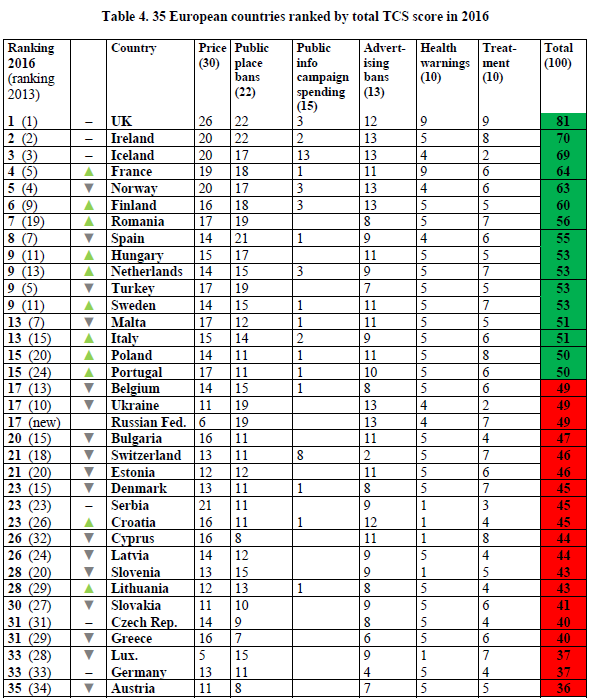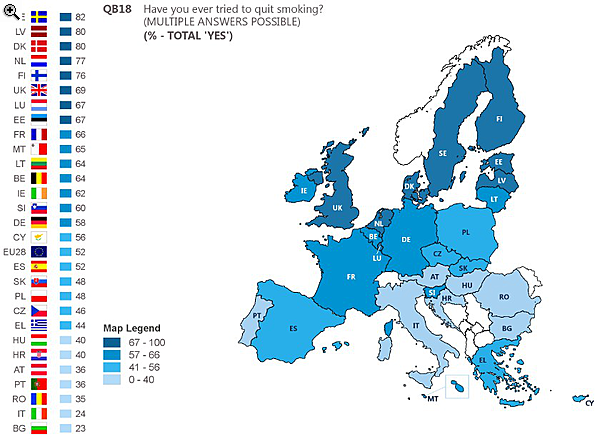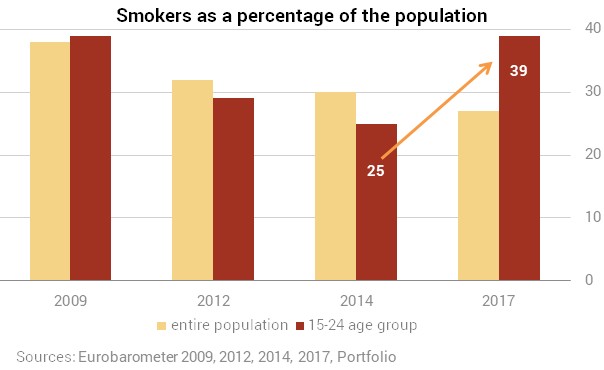The harmful addiction that claimed the lives of almost 1 mn people in Hungary
We are talking about one of the most common health-damaging activities on earth. About 1.1 billion people live with this harmful addiction, which has extremely serious social, economic and health consequences. It has been scientifically proven that smoking is also closely related to cardiovascular and respiratory diseases as well as cancer. It has been proven that there are 4,000 chemicals in tobacco smoke, of which 250 are harmful and 50 are directly related to the development of cancer.
If we approach it from an economic point of view, it is a special type of good that not only has a negative impact on its consumer but also on its environment. According to WHO estimates, smoking causes 1,000 billion dollars of damage annually to countries around the world due to additional health costs and word days lost, while tobacco revenues account for just 269 billion dollars.
What do these figures show in Hungary, how much of a harmful social and economic activity in smoking?
Tobacco-related illness and mortality statistics show that smoking is one of the most significant health risks in Hungary. Analyses have also been carried out in Hungary, indicating the direct and indirect cost of smoking to be 441 billion forints a year, but what is an even greater problem, is that
because of this harmful addiction we lose the equivalent of the population of a small town each year.
In other words this is also a major demographic problem in Hungary, as it is happening in a country where we have observed a naturally decreasing population since the early 1980s, i.e. more people die than are born.
The Institute for Health Metrics and Evaluation in Washington has been measuring the most important diseases and risk factors globally in relation to 195 countries since 1990 according to a research methodology published in ‘The Lancet’ journal.
According to the calculations based on the methodology, between 1990 and 2017, 882,000 people died in Hungary as a consequence of smoking.
The aggregate of 28 years was also a shocking result for me, as it means that between 1990 and 2017, almost a quarter of all deaths was attributable to smoking. It is important to know that there is a temporal shift between the harmful activity and the emergence of the disease or morbidity, which in the case of lung cancer can be up to 25-35 years.The fact that today there are so many individuals falling ill or dying due to smoking is because tobacco consumption in Hungary was notable 2-3 decades ago even compared to other countries, with an annual quantity of approx. 30 billion cigarettes. That is why it was important that with the measures implemented between 2011 and 2013, we started to repay our decades of debt in the area of tobacco control.
Which brings us to the tools used to fight smoking. There is a restriction of access, a ban on smoking in certain areas, and direct financial measures have been implemented, for which efforts are also being made within the European Union. What should be implemented by governments for effective discouragement?
The fight against smoking has been a process that has been ongoing for decades around the world, and there are countless opportunities available to governments. The results observed in relation to the discouragement of smoking are exemplary in many countries. Among the leading countries, it is worth highlighting Australia as well as the United States, where the process was launched in the 1950s and 1960s. As a result, the 42.4% smoking prevalence observed in the US in 1965 has now been reduced to 15.5%.
One of the most effective measures to reduce smoking is to raise taxes. In developed countries, a 10% increase in the tax on tobacco products will result in a 3-5% decrease in consumption.
This is a very well-researched area, and it is not proven in any way that the tax increase is directly proportional to the increase in illegal trading.Let us move on to Hungary, and look at the result of the set of measures introduces between 2011-2013, and whether they had a noticeable effect?
The measures introduced to discourage smoking between 2011 and 2013 can be seen as one of the most important public health measures of the past decades. The strong intentions of the health government to discourage smoking were demonstrated first by the amendment of the legislation on the protection of non-smokers, i.e. a total ban on smoking in confined spaces was the most important cornerstone of the fight against smoking, followed by a number of other significant measures:
- Transformation of the retail system of tobacco products;
- Introducing health-care warnings combined with images;
- Continuation of an active media campaign;
- Strengthening the institutional support system for the cessation of smoking;
- Multiple excise tax increase.
The most important achievement was the reduction in annual consumption to below 15 billion cigarettes from the previously measured 20 billion cigarettes (calculating with a conversion of 0.8gr = 1 cigarette - ed.).
It has never before happened that a country was able to implement so many measure within such a short period of time. For this reason, in 2013, the Hungarian Prime Minister received the ‘World No Tobacco Day’ award from the WHO Director General. The total ban on smoking in enclosed spaces was implemented within 76 days. This is not an easy task. Let us just think of Austria, where, after the ban was introduced, and despite the huge public outcry, due to the pressure imposed by a member of the coalition government, the ban was lifted in May of last year. But I could also mention Serbia, where they are also trying to introduce a ban on smoking in enclosed spaces. The World Health Organization also provides all the support necessary for this.
We are constantly carrying out research in this field at the Health Services Management Training Centre. We are in close contact with domestic and international experts of this field. The Hungarian set of measures was accompanied by great international attention, the most important results of which we presented at the 17th World Congress on the fight against tobacco use.
How can this be estimated? I would think that illegal trade and export-import can have a significant impact on these real data.
With the transformation of the retail system, compared to the former, more than 40,000 sales outlets (hypermarkets, gas stations, etc.), only 6,046 controlled locations were authorised to legally sell tobacco products as of 1 July 2013. The inventory system and data transfer system behind the retail system can monitor trade data at a national level.
In order to accurately estimate the annual tobacco consumption, one must be aware of the specificities of the domestic market, let us consider only the specific domestic situation of smoking tobacco (hand-rolled cigarettes). In addition to trade data, a record must be kept of the quantities legally imported, the illegal trade and the quantities legally exported from the country. As an example, let me mention what I heard two years ago at a conference held at the Austrian Academy of Sciences. The Austrian state loses out on tens of millions of euros in tax revenues per year due to the fact that so many people cross the border to purchase cigarettes, as here they have access to tobacco products 30-40% cheaper.
In addition to the transformation of retail system, we have implemented impressive and noticeable measures in this field. What other results can be highlighted?
Yes, the basis for all this was the amendment to the act relating to the protection of non-smokers, i.e. the total ban on smoking in public enclosed spaces. This was applied by the then government because of passive smoking. The indoor air quality was measured before and after its implementation, for example, in the entertainment venues the concentration of dust particles fell to 35 micrograms/cubic metre from the previously measured 924. This has a very positive effect on not only the health of guests but also those working there.
The WHO estimates that 890,000 deaths per year are caused by passive smoking globally. It must be accepted: there is no safe level of smoking.
Every three years, the Association of European Cancer Leagues measures and publishes where a particular Member State stands with the implementation of measures aimed at the discouragement of smoking. Hungary was in 27th place in 2010, by 2013 we advanced to 11th, and by 2016 we already reached 9th place. It should be noted that between 2010 and 2013 Hungary was the one that improved its position the most in this ranking.

In 2017, only 40% of smokers said they had tried to quit. This indicator has fallen by 15% compared to 2014, which means that the willingness to quit has dropped significantly and fewer active smokers say that they have tried to quit previously. The rate of decrease was highest in Hungary, after Romania and Italy.

However, we still have some time to wait for uniform packaging, the implementation of which has recently been postponed in Hungary from May this year for another two and a half years.
Clearly, this is the most sensitive point of the tobacco industry, as the product will practically lose its complete identity. And through Australia's example, we can see that it is a very important and effective milestone in the fight against smoking.
This year's introduction of this measure has indeed been postponed, which is also regrettable because the decline in tobacco consumption stopped after 2014.
In addition, a very negative trend can be observed among young people due to a drastic increase in prevalence.
This can truly be a warning sign for decision-makers. But how has smoking prevalence changed in Hungary in recent years?
In 1966, 57 per cent of men and 18 per cent of women smoked. In 2009, this figure changed to 46 and 32 per cent, respectively. In 2017, 35 per cent of men and 23 per cent of women smoked. By examining age groups, it can be stated that after 2009 a continuous decrease can be observed in all age groups.
There is an age group, namely young people, where a decrease was observed, but after 2014 this favourable trend was reversed and smoking prevalence has been increasing since.

There are several possible explanations for this. On the one hand, the primary targets of the industry are young people, for the manufacturers to hook them as soon as possible. Today’s nearly 2.5 million smokers in Hungary lit their first cigarette at the average age of 17.4.
The seriousness of the situation is only exacerbated by the enormous growth of cut tobacco in the last decade. Its popularity is growing mostly among young people: In 2009, only 1% of the 15-24 age group smoked hand-rolled cigarettes daily, with this number increasing to 44% by 2017.
Is this linked to the cost effectiveness of cut tobacco?
The main reason, indeed, is that cut tobacco has a tax advantage of over 50% compared to cigarettes. Of course, the tax advantage also signifies as a price advantage. The average price of fine cut smoking tobacco for 20 cigarettes is 500 forints, while a box of cigarettes costs 1,200 forints. All of this has also had an impact on cut tobacco consumption. In 2006, cut tobacco constituted 10% of the turnover, and by 2017 this figure had increased to close to 50%, which, compared to the EU, also created a unique market situation. This is a drastic transformation and it is important to acknowledge that this weakens the economic impact of any tax increase. As a result of the increase in cigarette prices due to the tax increase, there will always be those who choose the cheaper option and switch to cut tobacco. This tendency is concentrated in disadvantaged regions, where the occurrence of respiratory and cancerous diseases is also higher. Many people think that smoking tobacco is less harmful, but this is not true, especially its consumption without a filter causes more harm than factory cigarettes. In addition, this is not a good ‘deal’ for the state either, as it loses out on tens of billions of forints of excise tax.
As a result of previously implemented measures, it would be logical to believe that the black market for cigarettes has grown in Hungary, what estimates were used for this?
In 2017, approx. 9% of the total cigarette consumption was linked to smuggled and counterfeit cigarettes in the EU. Hungary is typically considered to be a transit country, as products from the Balkans or Ukraine are mainly destined for Western Europe. Prior to the implementation of the anti-smoking measures, the media loudly voiced the argument of the industry, according to which the impact of these measures will increase the size of the black market, redundancies are to be expected in the sector, and the state will lose significant tax revenues. Outside of our country this argument can be observed in the majority of countries around the world. What I would emphasise is that these arguments should be met with strong reservations. The estimation of domestic illegal trade is also surrounded by numerous uncertainties. I would like to mention two things in this regard. On the one hand, the numbers appearing in the press only show the extent of the cigarette trade in cigarettes, and the cigarette accounts for about 50% of the tobacco market in Hungary, and the percentages also include foreign-labelled cigarettes that could have been brought into the country via legal channels. It would be worth developing a new methodology that takes into account the specificities of the domestic market.
What other measures could be implemented in order to discourage smoking? Will there be a further tax increase as already expected by the EU ?
As I mentioned, tax increases are one of the most effective tools in the fight against smoking, so the increases must be continuous. It would be a step in the right direction if part of the surplus from increases were specifically directed towards healthcare, similarly to 2013.
In addition to tax increases, the implementation of other measures may also be considered. Such would be the raising of the age limit of 18 to 21 years, as is the case for some US states, for example.
Certain urban or institutional initiatives can also deliver significant results in the long run. The ‘Smoke Free EOK’ initiative was launched at our University with the help of the Budapest Medical Students’ Association.
At a conference, it even suggested that the public health tax be extended to tobacco products .
Already in 2012 we stated during our consultations with the Ministry for National Economy that alcohol and tobacco products should be subject to public health tax. Since then, this has been implemented for alcoholic products, but for tobacco products this is yet to be realised. In summary of the above, the spread of smoking tobacco is unfavourable to society in several ways:
- The state is losing out on tens of billions of excise tax revenues annually due to the nearly 50% market share of smoking tobacco.
- Due to its significant tax advantage and through its price advantage, it provides an escape route for cigarette smokers, which is why tobacco consumption remained almost unchanged between 2014 and 2017.
- Consumption is typically concentrated in disadvantaged regions, where the occurrence of respiratory and cancerous diseases is also higher.
- Its consumption is at least as harmful as cigarettes, and typically its consumption without filters can even be significantly more harmful.
- Smoking tobacco is an increasingly popular product in the 15-24 age group. In 2009, only 1% of the age group consumed hand-rolled cigarettes, compared to 44% of the 15-24 year-olds in 2017.
Our recommendation is that, like alcohol products, from among tobacco products smoking tobacco should also be subject to public health tax. The primary reason for this is the protection of young people as they are the primary ‘targets’ of the tobacco industry.
And how much of a threat is the e-cigarette for Hungarian consumers?
At EU level, the proportion of active users is very low, and in Hungary this figure is only 1 per cent at present, but its popularity is growing and its market share is increasing. It is worth mentioning that 80-90% of these products are linked to the classic tobacco companies. According to the healthcare professional directive on the support of smoking cessation, the role and effectiveness of e-cigarettes in the support of smoking cessation are not yet proven. It is however worth noting, that the use of e-cigarettes does not reduce but maintains nicotine addiction.








